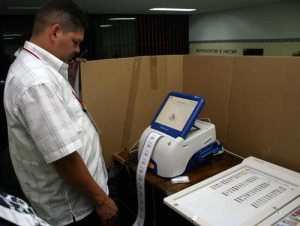
Venezuela uses voting machines and electronic ballots, which allow the country to have 100% automated elections.
When it comes to carrying out multiple elections—for example, simultaneous regional and legislative elections—, there are certain fears due to technical, logistic and security difficulties, which imply carrying out an activity where the selection of various posts is submitted to popular scrutiny at the same time.
Even though these processes entail a complex organization, and in many occasions countries opt for having them at intervals instead of planning simultaneous elections, the truth is that nowadays there are countries that have modernized their electoral system up to the point of being able to fulfill a tight schedule without falling into the dilemma of whether to follow it through or not, simultaneously or at intervals.
With manual voting, it is quite usual to debate about the potential problems that could arise during the organization of multiple elections, since there have been cases of failed or delayed processes, as well as those with numerous claims of mistakes or fraud. However, on the other hand, e-voting has become an ally in the fulfillment of a process where numerous posts must be chosen on the same day.
The efficiency of an automated suffrage is also reflected on its cost-effectiveness to the public budget, as the selection, training, and deployment of personnel in charge of polling stations is the same for all kinds of elections. Besides, there is no need to print millions of paper ballots, and the job of device programming, transportation and storage will not augment the cost of the endeavor.
Just as the financial weight is alleviated, with e-voting all technical and political worries dissipate, because the use of electronic machines or ballot boxes implies that electronic ballots (which can be reusable) can be employed and designed to hold as many posts and candidates as the election needs, simplifying the exercise of suffrage.
Another highlight in favor of simplifying the process of voting is that automation does not allow for the unnecessary extension of times for precinct count and tallying. This is because at the closing of the polling stations or polling centers, the machine computes tens, thousands or millions of votes in a minimum lapse and proceeds to transmit the exact results without prolonging the activity.
A situation that can showcase the success of e-voting in simultaneous elections is Venezuela. In this country, for example, during legislative elections, some regions must elect from 9 to 11 posts, but even if other selections are added, such as the renewal of province governors or mayors, the new requirements will not bring extensions in the time employed by the voter to exert his or her right, nor will it imply a significant rise in the cost or logistic complexities.
It must be added that the country, where the technology provided by Smartmatic has been used since 2004, will take one step further in electoral automation next October, as it will add a device to all voting machines to authenticate voters biometrically—by way of a fingerprint scan—to all the advantages it already has. This will facilitate the process for authorities to carry out simultaneous processes where voting can be allowed (or restricted) according to each citizen’s legal rights and limitations. Besides eradicating identity theft, this technologic solution will show the voter only the selections he or she is allowed to vote in due to his or her citizenship or legal condition.
Given this panorama, automation allows for the quick, secure, fair and user-friendly setup of a multiple election, which would be slower, more complex and probably full of security breaches if it was done through manual voting.
